Xerocomellus chrysenteron
Xerocomellus chrysenteron, formerly known as Boletus chrysenteron or Xerocomus chrysenteron, is a small, edible, wild mushroom in the family Boletaceae. These mushrooms have tubes and pores instead of gills beneath their caps. It is commonly known as the red cracking bolete.[1]
| Xerocomellus chrysenteron | |
|---|---|
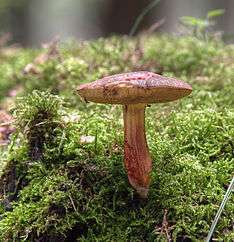 | |
| Scientific classification | |
| Kingdom: | |
| Division: | |
| Class: | |
| Order: | |
| Family: | |
| Genus: | |
| Species: | X. chrysenteron |
| Binomial name | |
| Xerocomellus chrysenteron (Bull.) Šutara (2008) | |
| Synonyms | |
|
Boletus chrysenteron Bull. (1789) | |
| Xerocomellus chrysenteron | |
|---|---|
float | |
| pores on hymenium | |
| cap is convex | |
| stipe is bare | |
| spore print is olive-brown | |
| edibility: edible | |
Taxonomy
This mushroom was first described and named as Boletus communis in 1789 by the eminent French botanist Jean Baptiste Francois Pierre Bulliard. Two years later in 1791 it was given the specific epithet chrysenteron by the same author. The species name coming from the Ancient Greek words khrysos "gold" and enteron "innards".[2] Almost one hundred years later in 1888 Lucien Quelet placed it in the new genus Xerocomus, and retained the chrysenteron epithet. This binomial was generally accepted for almost another hundred years, until 1985 when Marcel Bon decided to resurrect the former specific epithet communis, which resulted in the binomial Xerocomus communis. It now resides back in the genus Boletus, and sports its 1791 binomial, and authority once again, and is currently known as Boletus chrysenteron Bull. Recent phylogenetic analysis supports the placement of X. chrysenteron as the type species of the new genus Xerocomellus, described by Šutara in 2008.[3]
Description
Young specimens of X. chrysenteron often have a dark, dry surface, and tomentose caps which might easily be mistaken for Bay Boletes Imleria badia. When fully expanded, caps are 4 to 10 cm (1.6–4 in) in diameter with very little substance and thin flesh that turns a blue color when slightly cut or bruised.[4] Caps mature to convex and plane in old age.[5] Cracks in the mature cap reveal a thin layer of light red flesh below the skin.[4] The 10 to 15 mm-diameter stems have no ring, are bright yellow and the lower part is covered in coral-red fibrils and has a constant elliptical to fusiform diameter throughout its length of 4 to 8 cm tall.[5] The cream-colored stem flesh turns blue when cut. X. chrysenteron has large, yellow, angular pores,[6] and produces an olive brown spore print.[4]
Fruit bodies of Xerocomellus chrysenteron are also prone to infestation by the bolete eater (Hypomyces chrysospermus).
Similarities within taxa
Macroscopic observation of Xerocomellus chrysenteron is not sufficient to determine this species with certainty, as many intermediate forms occur between it and other taxa; in particular, some forms of B. pruinatus and Hortiboletus rubellus are hardly distinguishable from B. chrysenteron without the aid of microscopic characters. B. porosporus is also similar to this species, but it is easily separated on account of the whitish under layer and truncate (chopped off) spores.[7] Also this species is easily confused with B. declivitatum.[1]
Distribution and habitat
Xerocomellus chrysenteron grows singly or in small groups in hardwood/conifer woods from early fall to mid-winter. It is mycorrhizal with hardwood trees, often beech on well drained soils. It is frequent in parts of the northern temperate zones.[6] The species has been recorded in Taiwan.[8] It has been introduced to New Zealand, where it grows in groups under introduced deciduous trees.[9]
This species may not be as common as once thought, having been often mistaken for the recently recognised B.cisalpinus Simonini, Ladurner & Peintner.
Edibility
Xerocomellus chrysenteron is considered edible but not desirable due to bland flavor and soft texture.[10] The pores are recommended to be removed immediately after mushrooms are picked as they rapidly decay.[11] Young fungi are palatable and suitable for drying, but they become slimy when cooked; mature specimens are rather tasteless and decay quickly.
Gallery
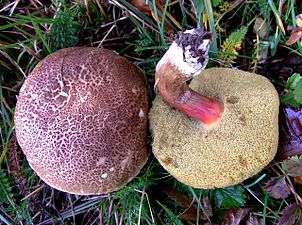 Maturing Boletus chrysenteron
Maturing Boletus chrysenteron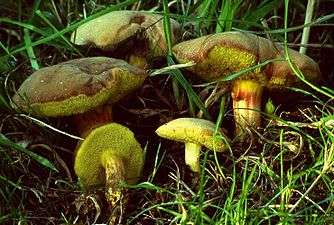 Showing large yellow pores
Showing large yellow pores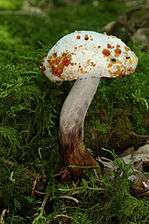 Mold growing on old boletus chrysenteron
Mold growing on old boletus chrysenteron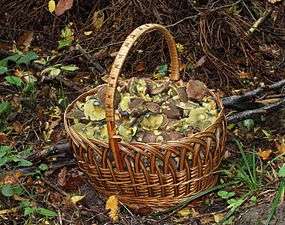 Picked Xerocomellus chrysenteron in basket
Picked Xerocomellus chrysenteron in basket
See also
References
- Roger Phillips (2006). Mushrooms. Pan MacMillan. ISBN 0-330-44237-6.
- Nilson S, Persson O. (1977). Fungi of Northern Europe 1: Larger Fungi (Excluding Gill-Fungi). Harmondsworth, UK: Penguin. pp. 106–07. ISBN 0-14-063005-8.
- Šutara J. (2008). "Xerocomus s. l. in the light of the present state of knowledge" (PDF). Czech Mycology. 60 (1): 29–62.
- "Xerocomus chrysenteron". First Nature. Archived from the original on October 26, 2007. Retrieved 2007-12-12.
- Michael Wood & Fred Stevens (1996–2007). "Xerocomus chrysenteron". The Fungi of California. Retrieved 2007-12-12.
- Thomas Laessoe (1998). Mushrooms (flexi bound). Dorling Kindersley. ISBN 0-7513-1070-0.
- G. Bresadola (2005-05-02). "Xerocomus chrysenteron". Gruppo Micologico «G. Bresadola». Archived from the original on June 6, 2011. Retrieved 2007-12-12.
- Yeh K-W, Chen Z-C. (1980). "The boletes of Taiwan" (PDF). Taiwania. 25 (1): 166–184.
- McNabb RFR. (1968). "The Boletaceae of New Zealand". New Zealand Journal of Botany. 6 (2): 137–76 (see p. 148). doi:10.1080/0028825X.1968.10429056.

- Arora D. (1986). Mushrooms Demystified: A Comprehensive Guide to the Fleshy Fungi. Berkeley, California: Ten Speed Press. p. 519. ISBN 0-89815-169-4.
- Haas H. (1969). The Young Specialist looks at Fungi. London, UK: Burke. p. 44. ISBN 0-222-79409-7.
External links
| Wikimedia Commons has media related to Xerocomellus chrysenteron. |
| Wikispecies has information related to Xerocomellus chrysenteron |